How To Catch Salmon In A River: Guides Explain Methods And More
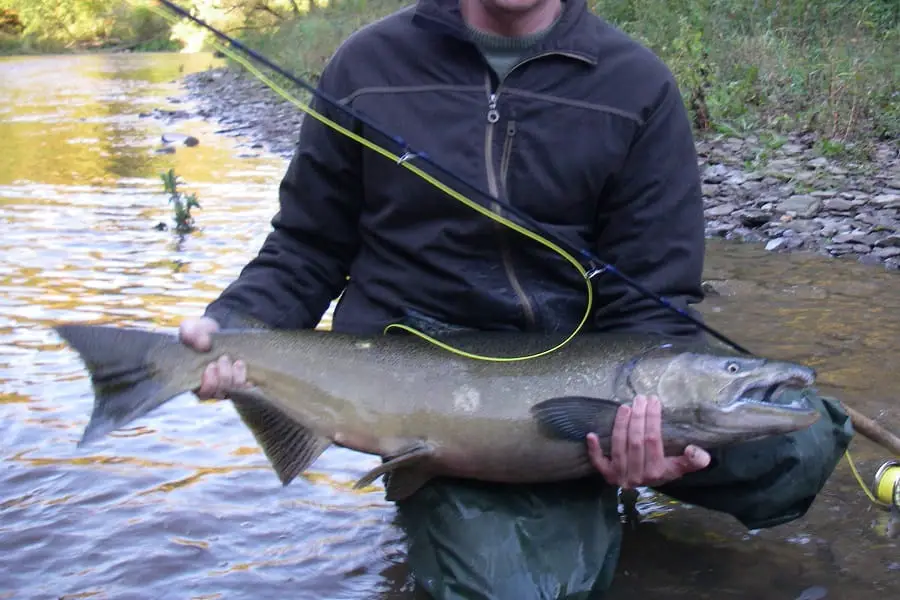
I have been teaching anglers how to catch salmon in rivers for over twenty years, and in that time, I’ve been able to determine the most important factors to consistently catch salmon during their spawning runs.
If you are new to salmon fishing or want to get better at fishing for salmon in rivers, some of the most important things to know are:
- Gear: Depending on the salmon species and the method of fishing you prefer, it is important that you use the right gear that can handle the salmon and present your bait or lure effectively. Larger gear is required for bigger chinook, coho, and chum salmon. Gear includes rods, reels, and lines.
- Where to fish: You should know where in your area to target salmon, which includes the best rivers. You should also have an understanding of where in the river the salmon travel and hold so you know where you should be fishing.
- When to fish: Having a good understanding of when the salmon enter the rivers can help ensure you are there and fishing when the salmon are there.
- What methods to use: There are numerous methods, which include fly fishing, float fishing, drift fishing, plunking, and some boat fishing methods like back bouncing, back trolling, and side drifting.
- Baits: There are many baits you could use, but after 37 years of salmon fishing and testing out baits, only a few baits are consistently effective. Baits like spawn bags, skien, beads, shrimp, and plastic worms are good options.
- Flies: Salmon do like flies, which is why so many guides and anglers use fly fishing methods. Flies such as nymphs, egg patterns, and steamers are good options.
- Lures: Many guides and anglers will use spoons, spinners, crankbaits, and plugs to catch all species of salmon.
- Leader Set-up: Regardless of the bait, it is very important that you use the current leader setup for each method. Using the right size leaders, hooks, and weights can make a huge difference.
- Presentation: Presenting your bait or lures properly can increase your ability to catch more salmon, so it is important that you learn to master your presentation.
I have first-hand experience with all of these things, and I make sure to utilize them when I am guiding and fishing for salmon in the rivers. I teach these things to my clients, and I explain them to you in this article.
How To Catch Salmon In A River
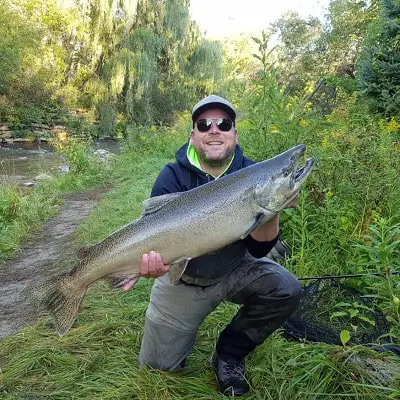
Anglers will fish for mature adult salmon that enter the rivers of the Pacific Ocean or the rivers around the Great Lakes.
My experience has shown me that salmon fishing is the same in both areas, with a few minor differences in when the salmon enter the rivers and the baits and gear used.
Salmon often enter the rivers by the thousands, making for some easy and exciting fishing.
There are times when so many salmon will enter rivers that they are so concentrated that anglers can sometimes catch 20 or more in a day. Some of these salmon can be over 40 pounds.
There are many salmon species, and all can be caught once they enter the river. The most common species include Chinook, Coho, Chum, Kokanee, Pink, and Atlantic Salmon.
This concentration of salmon means that most methods and many different baits, lures, and flies can be used.
The other cool thing about salmon fishing is that it’s not uncommon to catch other species, such as large steelhead or very large migratory brown trout, at the same time. All of these fish can be in the same spot at the same time and can be caught using the same methods and baits
When Do The Salmon Enter Rivers: Timing The Run
If you want to know how to catch salmon in a river effectively, then you need to be on the river at the right time. This is important. As a guide, I’m on the water every day, so I see how one day as the run comes through, many salmon will be caught, but a few days later, the fishing can be very slow.
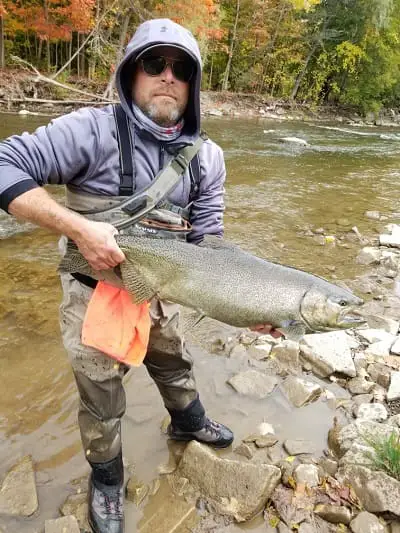
If you know when the salmon enter the rivers in large numbers, you can catch a lot more salmon and learn a lot more. I call this “timing the runs,” and this is a part of salmon fishing.
There are certain things that trigger the salmon to run, and if you know what they are you can be there on the good days.
Learning the triggers and timing the runs is important for catching salmon in a river.
In most areas, the bulk of the salmon will enter the rivers in late summer or early fall. Great lakes salmon will often enter rivers in late September and October.
Rains Will Trigger Salmon Runs
Some salmon rivers get very low after the spring floods and it takes significant rainfall to increase river water levels, which will then trigger the salmon to run. It is a good idea to be on the river during this increase in water level, or be there at the river starts to drop and the water starts to clear up.
Temperatures Trigger Salmon Runs
In some areas, if the river is too warm at the mouth of the river the salmon will wait before they run up the rivers.
Cooling nighttime temperatures might see runs overnight and in the early morning. As river temps cool, salmon will start working their way into the rivers, especially if the river flow is sufficient.
On some rivers that already have large flows even without the extra rainwater, once the river temperatures hit the desired temperature of the salmon, the salmon can run up the rivers based on just the temperature alone.
50 to 60 Fahrenheit water temperatures is sufficient for salmon runs.
Wind Can Trigger Salmon Runs
String in-shore winds can push salmon in closer to shore, where they may locate their preferred river, and this can trigger them to run. Look for strong winds pushing into shore and try fishing on these days.
River Locations
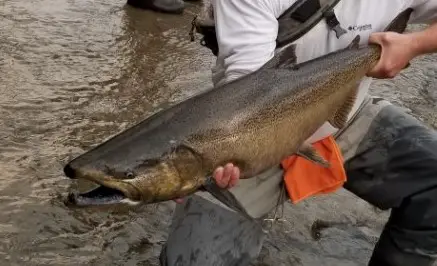
I’m about to let you in on a key secret, which can significantly improve your success on the river.
When I say fishing river locations, I’m not talking about where the rivers are or where the access spots are.
River guides and local fishing experts will change locations within a river or change river all-together based on current conditions, the weather, and the stages of the run.
These experts know how to time the runs of salmon and the river conditions to maximize their success and time on the water. Doing so can be the difference between catching no salmon or catching lots of salmon.
Not knowing how to do this well is the reason why I hear new salmon anglers tell me they caught no fish when I, other guides, and my buddies are catching over 20 a day. We just know where the fish are based on current conditions, or past rains and past runs.
What guides and my buddies do is they time the runs based on the weather and river conditions. This means they only hit certain rivers at select times when the most fish are there or when the conditions are favorable.
What I mean is that if it just poured rain, a small river could get a big run of salmon. But if it hasn’t rained for a week and that river is low, the chances are that salmon fishing will be bad since no salmon will have entered the river recently.
It also could mean that if the small rivers are low and clear with no recent salmon runs, the bigger rivers will be the best bet since they don’t always require rain for fresh runs of salmon to come in.
However, if it rained hard and the bigger rivers are flooded or dirty, the small rivers will clear faster and the salmon will be there and be easier to catch.
I and other guides will also fish different sections of the river on different days, based on my knowledge of where the fish are, or aren’t.
I call this following the runs. Let me explain.
After big rains, most of the salmon will be closer to the mouth of the river or in the lower 5 to 10 miles of the river, and this is the place to be fishing. These fresh salmon are the hardest fighting fish and are usually concentrated as they all come up at once.
Four or five days later, especially if no further rains occur, there will be fewer salmon in the lower river as they have all moved further up the rivers and spread out. This means it’s better to fish up the river.
On some rivers, the salmon might be able to move only 5 miles a day, this happens on the smaller rivers that are shallower or have lots of obstructions. On larger rivers, salmon might swim 20 miles a day. This means three days into a run on a river where they move 20 miles a day I will likely be fishing or guiding my clients 50 to 60 miles up the river. I’m following the runs, and this has led to great success.
Anglers that don’t do this might be fishing their favorite spot near the mouth and catching nothing while my clients are catching 20+ fifty miles up the river.
I may also change location based on conditions such as water clarity.
If it hasn’t rained for a week or more, the rivers can become very low and very clear, and this slows salmon migrations so they will often hold in deeper pools.
Clear rivers can be difficult to fish since salmon can detect anglers walking around the waterway. A Salmon’s eyesight is incredible during these periods, as is their ability to pick up vibrations from stumbling and heavy-footed anglers. This can make fishing difficult so I may choose to go to another river.
If I do stay and fish during these low water conditions, it’s always best to fish for salmon in the biggest and deepest pools or in sections with some kind of cover like log jams, or boulders where they will concentrate and wait for higher water before they start moving again.
You may also find that during these super low water conditions and when no rains have occurred for a long time, there can be a lot of salmon that haven’t run yet, and they will be staging at the river mouths. If that is the case, fishing the mouth can be the hot spot.
These staging salmon are the next runs of salmon to come with the next rains, and while guys are up the river looking for salmon that are spread out, other guys are smashing them at the mouth of the river.
This knowledge comes with lots of time on the water catching thousands of salmon and seeing where they hold. I will share this info with you.
Catching Salmon If It’s High Or Dirty
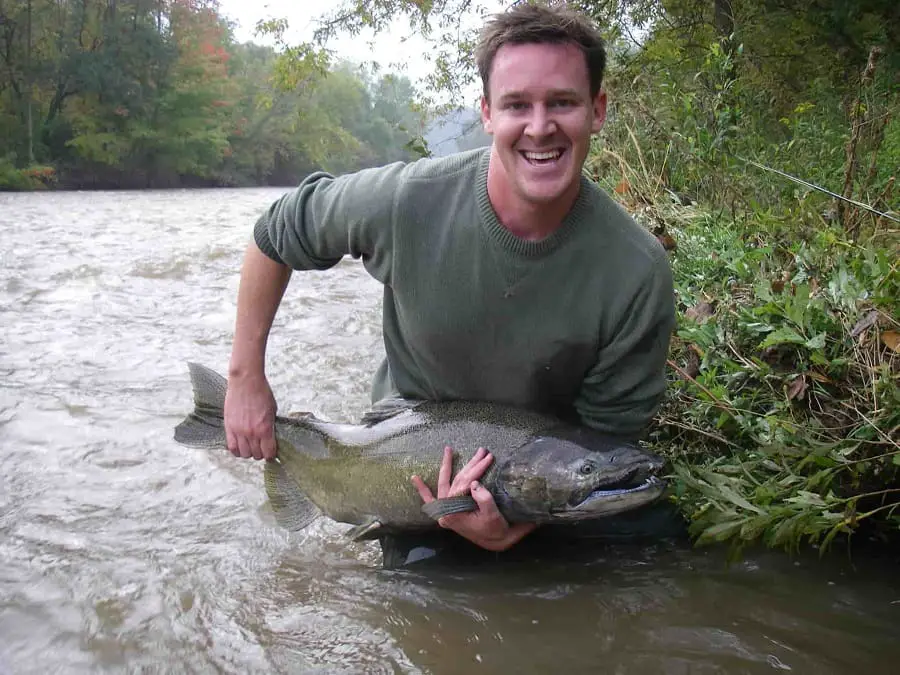
You already know that the big rains often bring in lots of salmon into the river, which is a great thing. However, during heavy rains, the rivers and streams can become dirty, turbulent, and even dangerous.
When the tributaries are high, anglers find it difficult to fish, especially in the lower sections of the river, where the rivers are often dirtiest or highest, thanks to all the runoff from little tributaries and fields up the river. Dirty water simply means the salmon can’t locate your bait.
The creek’s bottoms can also become dangerous with slippery rocks and shale or deep ledges that you can’t see.
During this high dirty water time, anglers have the option to fish smaller rivers that clear faster or may not have become as high and muddy. Or, anglers can go further up into the headwaters, where the rivers tend to stay clearer. I will do both, depending on the best option.
I will also sometimes target the smaller, clearer tributaries of the bigger rivers and fish up these tributaries or at the mouth of them.
During high waters, it is difficult to see where you are stepping in fast-moving and murky water. Therefore, anglers should fish near the edges of the rivers.
Guide Tip: When the water is high and muddy, I look for travel routes and concentration spots. I also fish closer to shore since the calmest and slowest is water is near the bank, and salmon will often move out of the very fast water and swim up the edges of the river.
Concentration spots might be small pockets or areas that funnel the salmon. You can see in the picture below the slower water on the right side. That slow water just below the rapids is a concentration spot, and the salmon will hold there before they shoot up through the fast rapids.
Float Fishing
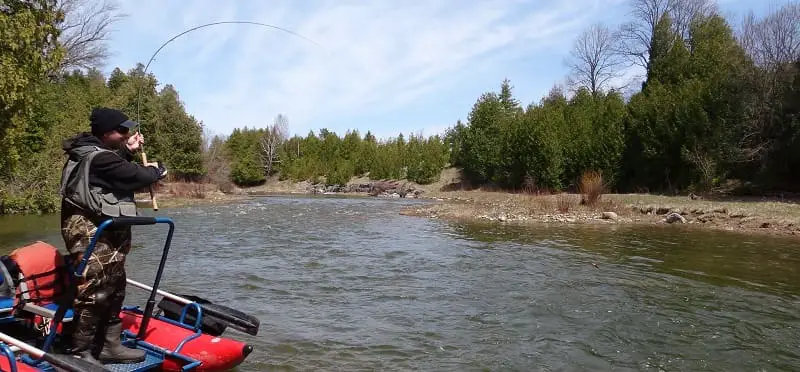
You should know that one of the most effective methods for salmon fishing is to float fish.
Float fishing for salmon simply means you are presenting a bait below a bobber, which is more commonly called a float by river anglers. You drift your float and your bait down the river to the fish in the most natural way possible.
The float suspends your bait just off the bottom and keeps it in the strike zone longer.
Float fishing can be very effective in any water that is over 3 feet deep and under 15 feet deep. However, the use of slip float can allow anglers to fish deeper if needed.
Float fishing can be done using spinning reels and long rods, Centerpin reels and rods, or even with baitcasting reels. Depending on what part of the country you are fishing, different methods might be more popular.
Many anglers like to use spinning reels for float fishing. I discuss the best methods for float fishing on my page, Float Fishing For Salmon – A River Guides Advice
Float fishing requires the use of baits, and the most common bait is the spawn sac or roe bag. I use a lot of baits and will rotate baits to find the best one based on the conditions or what the fish want, so it’s smart to have a few options in your vest or pack.
I also found that some baits work better at certain times of the year. I discuss the top baits on my page Best Salmon Baits, however, I have recently updated that page and it now has 7 of my best baits and link to more great baits.
Spin Fishing
Anglers who want to know how to catch salmon will often think of spinning rods and reels.
Spinning rods are popular everywhere that guys fish for salmon. With a spinning reel, you can float fish, bottom bounce, cast lures, and even still fish. Spinning reels are also used when trolling from a riverboat.
However, if you want to float fish, I highly recommend learning how to use a Centerpin reel since it’s better than a spinning reel.
Spinning Reels For Salmon
When spin fishing for salmon, you want to get a reel that has a good, smooth drag system that can handle fast-pulling fish like salmon. Good bearings are also important, and so is a spool that can hold a lot of line.
If you are new to salmon fishing in rivers and need to get a reel, check out my page on the best spinning reels for float fishing, and for lure fishing, or just general steelhead fishing.
Generally, you want a reel in the 3500 to 4500 size. These reels will have a stronger drag system and will hold more line.
Best Spinning Rods for Salmon Fishing In Rivers
My favorite salmon spinning rods are medium to medium heavy rods from 8 to 10 feet which are great for casting lures or using still fishing methods like plunking. I prefer medium salmon rods from 11 to 14 feet for float fishing and drift fishing methods. A good rod for both casting lures and float fishing would be between 9 and 11 feet.
Lines For Salmon Fishing In Rivers
I use 10 to 16-pound test and only use the proven and tested salmon lines for salmon steelhead fishing in rivers. The line size and type I use will depend on the method I am using.
Good line options for salmon are monofilament, fluorocarbon line, or braided line, but each has its pros and cons depending on the method I use.
In some situations, like when I’m float fishing or drift fishing for salmon, I prefer colored lines, but when casting lures, clear lines are best.
Centerpin Fishing
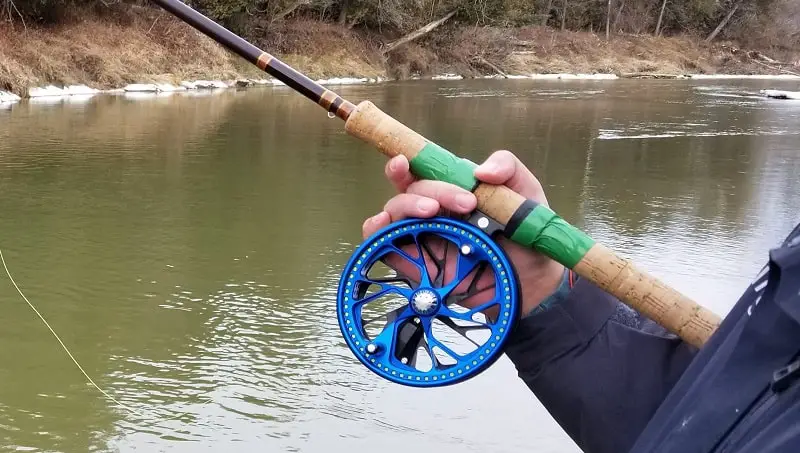
I have been Centerpin fishing for over 30 years and I have been guiding and teaching anglers how to Centerpin fish for salmon and steelhead for about 20 years. I can honestly say that in most rivers Centerpin fishing is by far the best method for catching salmon in rivers of all sizes.
Centerpin fishing is simply using a large round reel that looks like a fly reel, but it holds mono or braided line, and it has no drag. The Centerpin reel free spools, and it’s designed to drift a float with a bait down the river. The free spool of the reel and the smoothness of the reel allows for the best possible presentation of the bait.
The Centerpin reel is combined with long rods, which help with presentation and help to fight and land big fish.
This method is deadly on salmon, steelhead, and even trout in rivers if it is done right.
I discuss the setup, the leaders, the baits, and how to present the bait, and more on my page Centerpin Fishing For Beginners: 20 Steps From A Top Guide. Basically, everything you need to know to be a great Centerpin angler can be found on that page.
If you are a river angler who wants to catch more salmon, then I highly recommend you learn about this method.
Fly Fishing
Fly fishing for salmon is my preferred method for catching salmon because I find it more challenging than some of the other methods and because it’s fun. If done right, fly fishing for salmon can be very effective, and in some river situations, it can be more effective than bait fishing and float fishing.
Fly fishing for salmon can be done using four different methods of fly fishing, which include Nymph Fishing, Streamer fishing, Spey fishing, and even Euro Nymphing. Fly fishing for salmon is often most effective in river sections from two to eight feet deep.
I discuss each of these fly fishing methods and how to do them, as well as the best setup, leaders, flies, and more on my page Fly Fishing For Salmon.
If fly fishing is something you think you might be interested in, you won’t find another resource that will provide you with as much information, tips, and proven tactics on fly fishing for salmon as you will find in my series on fly fishing for salmon, starting with that page.
Bottom Bouncing For Salmon In Rivers
Bottom bouncing is an old-school method that anglers used to use when salmon and steelhead fishing and some anglers still use it today. It has been overshadowed by the float fishing anglers that seem to catch more fish.
However, bottom bouncing can be the most effective method in smaller, shallower rivers and creeks and in pocket water. It can also be very effective for trout and for steelhead.
I have outfished the float fishing guys 5 to 1 on some rivers when the salmon are on the move and are spread out in the pools, riffles, runs, and pockets using bottom bouncing.
I have also made the old style of bottom bouncing much more effective than it ever has before using what I call advanced bottom bouncing.
Drift Fishing For Salmon
Drift fishing for salmon is similar to bottom bouncing, in fact some would say they are the same thing.
Drift fishing is often used by anglers on larger, faster rivers and on deeper rivers. The idea is to use a drift fishing setup, cast into the main current, let the weight and bait sink to the bottom, and follow the line down the river with your rod tip. You wait for the line to stop or pull, which indicates a bite.
The good thing about drift fishing is you can fish water 30 feet deep or less. The hard thing about drift fishing for many anglers is detecting a strike when your bait is deep or far from you.
Drift fishing requires a lot of current and just enough weight to get your bait down while not too much that you are constantly stuck on the bottom.
Lure Fishing
Lure fishing is a favorite and effective way of fishing for salmon. Casting lures from shore or a boat can be exciting, and it can provide anglers the opportunity to have hard hits and multiple salmon hookups.
Lure fishing can be done effectively from the river banks, the shoreline of the lake or ocean, and from the pier of the river mouths.
Good lures for salmon can include plugs, spinners, spoons, jigs, and more.
On my page, Lure Fishing For Salmon, I discuss the best lures, sizes, colors, as well as tips on how to catch more salmon using lure fishing methods that the guides use.
Twitching jigs for salmon is also a really good method for all salmon species.
Salmon Leaders For All Methods
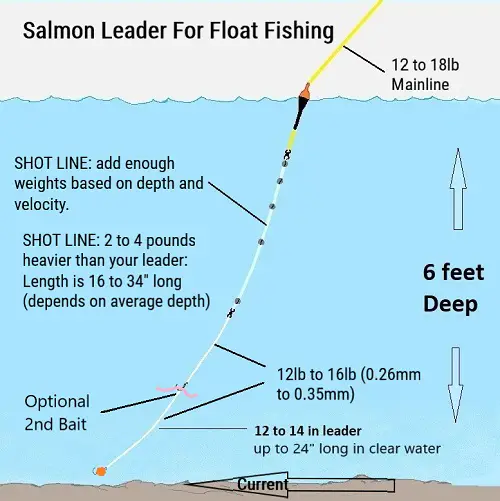
Having good leader setups is always important.
I discuss all the most effective leaders for the primary methods of salmon fishing.
See expert leader setups for float fishing for salmon, drift fishing, plunking, and fly fishing at Salmon Leaders and Setup.
Guide Tip: Catch More Salmon

Salmon fishing along many rivers can mean crowds and many anglers fishing in the same area can make the salmon go lockjaw and stop eating. Guys often ask me for advice on how to catch more salmon. There are many ways to do this.
A tip that I give to my buddies and clients is to get away from the crowds by using riverboats. I use 1-man, 2-man, and 3-man pontoon-style boats that weigh between 30 pounds to about 130 pounds.
These boats enable me to get far away from the crowd or get me into sections of the river that flow through private property where nobody else can fish. If I had to guess, using boats to access secluded water has accounted for thousands more salmon, steelhead, and trout for my clients.
You can do this easily and cheaply, and I will tell you how.
Some years I will spend 100 days on the water during the fall months, and I will sometimes only see about ten anglers in the sections where we fish.
Using a riverboat like an inflatable pontoon boat has been the reason why many of my clients have experienced 10 to 50 salmon a day when other anglers in the public sections are only catching a few or none.
To see how I do this and all the ways to do it easily with 1 or 2 anglers, and to see the best boats for this, check out my page on River Boats For More Fish.
Boat Fishing
Salmon fishing by motorboat is another method that anglers use on bigger rivers, lakes, and oceans. I will cover motorboat fishing methods that are used out in the lakes and oceans and on the bigger rivers at a later date and in a separate article.
Catching Salmon When Shore Fishing And Pier Fishing
Pier fishing is popular with anglers because this is where you have the opportunity to catch large salmon staging at the mouths or just entering the rivers, and these salmon are full of energy and are at their strongest.
Salmon that have not been fighting the current for miles will often fight harder and longer because they have more energy, which is why many anglers will gravitate to the lower sections of rivers and to the piers.
Anglers will often cast lures or baits from the shores along the Ocean or great lakes near the river mouths. This can be a very effective method.
I will cover pier and shore fishing methods in another article, so check back soon.
Tight Lines
Graham
